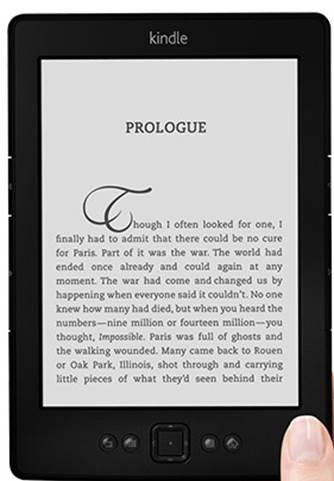Amazon Kindle
Price: $103.5
Supplier: www..com

Amazon
& Kindle
There isn’t much difference between the
new, non-touch $103.5 Amazon Kindle and the old $133.5 version. Aside from a
change to black from gloomy grey, and that $30 price drop, the new device looks
exactly the same. All the buttons and ports are in the same locations. There’s
still 2GB of internal storage available, with no expansion, and there’s been no
change to file format support. The Kindle will not load DRM-protected EPUB
files natively, or via conversion, so you won’t be able to load books from
third party eBook stores and local libraries. Amazon’s eBook selection is as
good as it gets, though, and this model retains a lead in the most important
area for an eBook reader: the display. It may not have the swanky front light
of the Kobo Glo, Nook or Kindle Paperwhite, but its page background is closer
to print than ever, text looks crisper and darker than any other reader we’ve
used, and page turns are rapid, too, at 0.4 seconds. At this price, it’s hard
not to recommend.
Kobo Mini
Price: $90

Kobo
Mini
Kobo’s diddy eBook reader makes a brave
break from the norm. Instead of the usual 6in display, the Mini has a more
compact 4.9in E Ink panel, which makes it possible to slide into a jeans
pocket, as well as a bag or briefcase. It measures a svelte 102 x 10 x 133mm
(WDH), is lighter than an iPhone 4S, and yet retains a similar feature set to
the Kobo Glo. There’s Wi-Fi, allowing you to buy books on the device from the
Kobo store. It has infrared touch sensors embedded in the bezel, allowing pages
to be turned with a swipe or tap of the screen. Even the onscreen touch
keyboard isn’t too fiddly. Alas, it doesn’t have the same fantastic front light
as the Kobo Glo, and when it comes to display quality its Vizplex V110 panel
can’t hold a candle to the others here. The resolution is fine at 600 x 800 and
text is crisp, but the “page” looks considerably greyer.
Kobo Glo
Price: $150

Kobo
Glo
Kobo’s first touchscreen eBook reader
appeared in the UK last Christmas, and we were impressed with it. We liked the
design, with its unusual quilted soft-plastic rear and matte-white front; we
liked the store, the user interface and the display. We’re even more enamoured
with its successor, the Kobo Glo, which adds an integrated light, similar to
the one in the Amazon Paperwhite and Nook Simple Touch. The Kobo Glo
distributes the light more evenly than the Nook, and is brighter on its maximum
setting than the Paperwhite. This means that when you switch on the light even
in bright sunlight the page on the Kobo looks as white, if not whiter than paperback
books. The sense of print on paper is further enhanced by the 758 x 1,024
resolution, matching the Kindle Paperwhite for pixel count and crisp, sharp edged
characters. The Glo’s page is a little less white than the Kindle Paperwhite
when the light is switched off; the quoted battery life is lower; and it can’t
match the Kindle’s super-quick page-turn speeds, coming in at 0.9 seconds
compared to the Kindle’s 0.6 seconds. On the positive side, though, the Glo is
compatible with the DRM EPUB files used by WHSmith, Waterstones and local
libraries in the UK, and that’s in addition to its own store, which is accessed
on the device via Wi-Fi. It’s also $13.5 cheaper, making it a very tempting
alternative to Amazon’s market leader.
Kindle Paperwhite
Price: $163.5 (Wi-Fi);
$253.5 (Wi-Fi and 3G)
Supplier: www..com

Kindle
Paperwhite
You could be forgiven for wondering how
Amazon could improve on its already excellent range of eBook readers. The
Kindle Paperwhite is its answer: initially only launched in the US, the
Paperwhite is now available to UK consumers and a good thing too. As with the
Nook and Kobo Glo devices, the Paperwhite features an integrated light embedded
in the bottom bezel. This shines through an anti-glare layer, illuminating the
entire display with a soft, white light. It’s perfect for reading in bed, and
Amazon is so confident about the efficiency of the light that you can’t
completely turn it off. Battery life is impressive, too, although note the
claimed eight weeks is with the light set to 40% brightness, which doesn’t
improve the contrast at all in daylight. There are other improvements, though.
The touchscreen uses capacitive technology, replacing the optical system of
old. We couldn’t perceive a tangible operational advantage, but it has helped
slim the Kindle down; it now measures only 9.2mm thick. The resolution of 758 x
1,024 gives ever-so-slightly crisper characters than the old 600 x 800 panel
too. The screen doesn’t have as much contrast as the standard Kindle with the
light set to its lowest point, but in every other respect, this is a fantastic eBook
reader. The light is the most even of all the front-lit readers, the overhauled
user interface is excellent, and it’s a pleasure to read with. It just about
holds onto top spot in the eBook reader race a hair’s width in front of the
cheaper Kobo Glo.